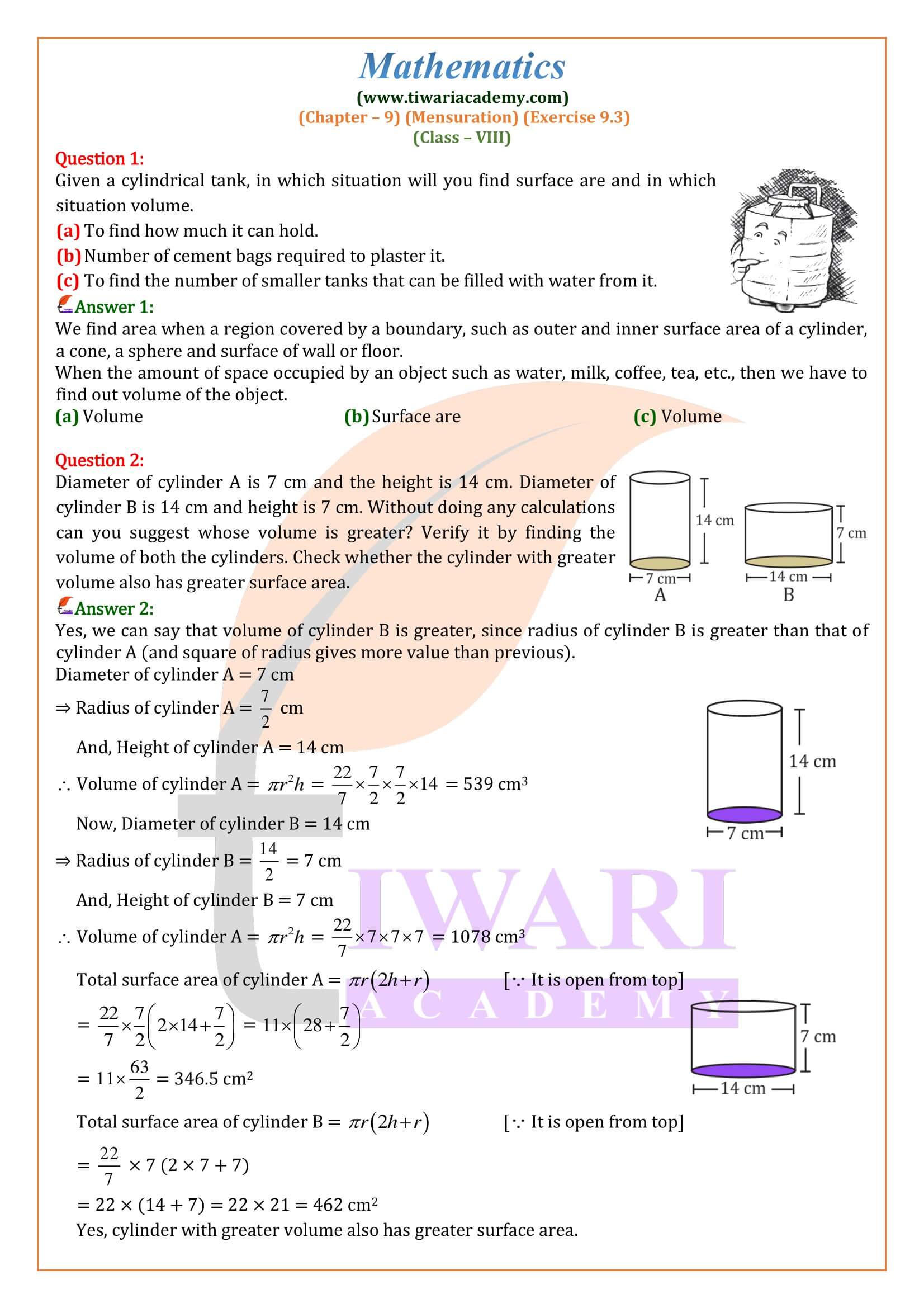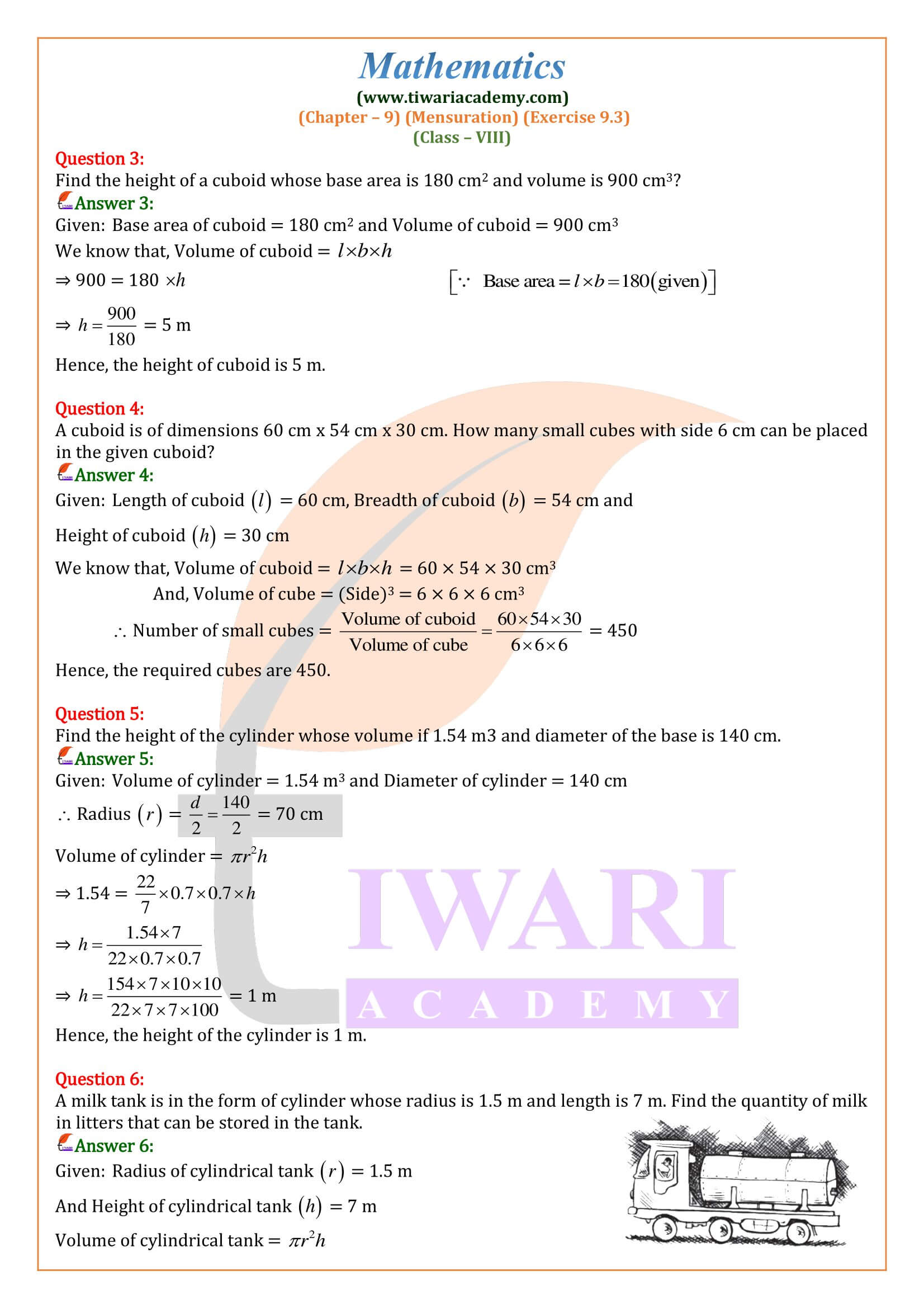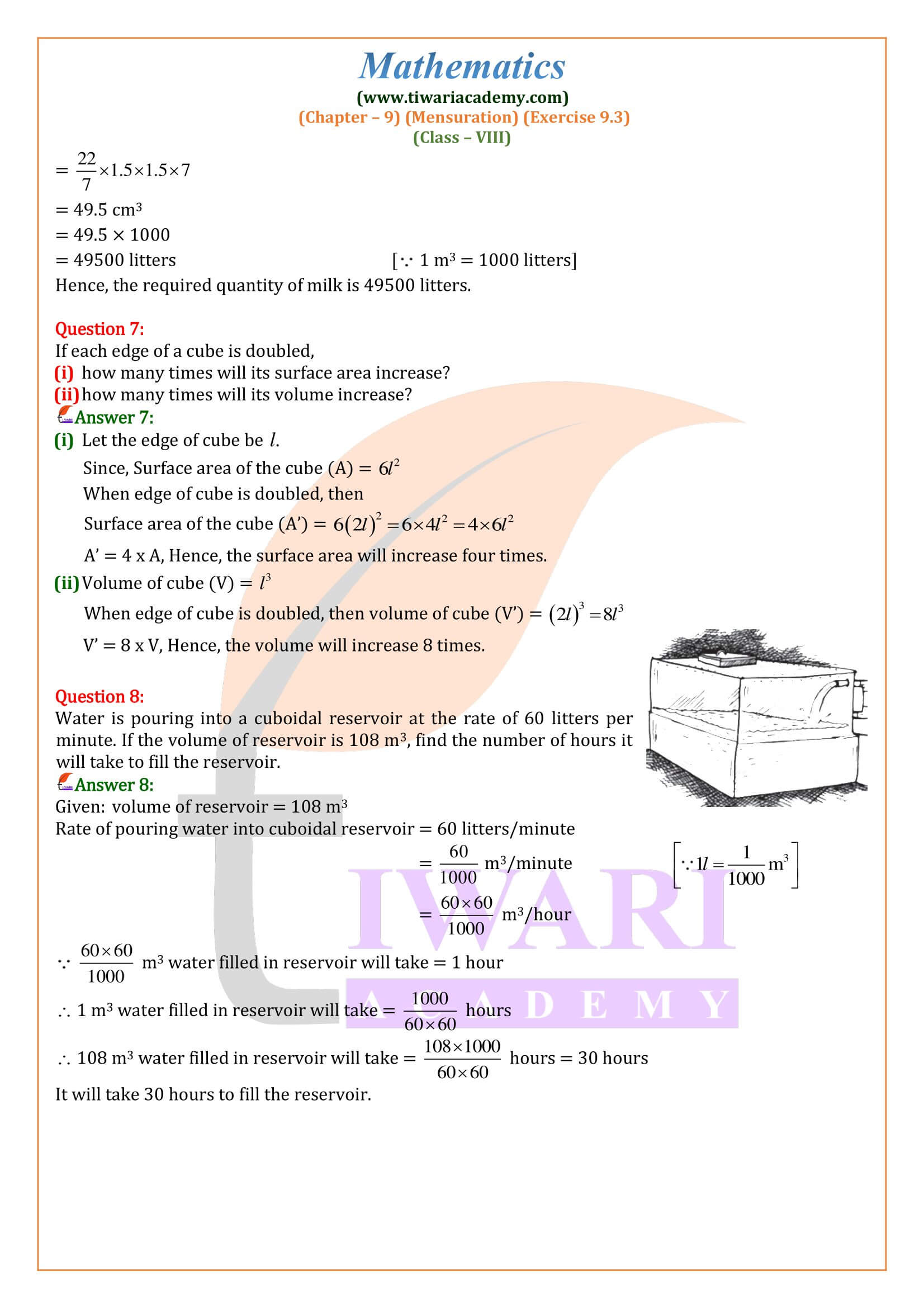NCERT Solutions for Class 8 Maths Chapter 9 Exercise 9.3 Mensuration in Hindi and English Medium updated for session 2025-26. Students of class 8, can get here the revised solutions of ex. 9.3 based on updated syllabus and new NCERT books for academic year 2025-26.
8th Maths Exercise 9.3 Solution in Hindi and English Medium
| Class: 8 | Mathematics |
| Chapter: 9 | Exercise: 9.3 |
| Chapter Name: | Mensuration |
| Content Type: | Videos and Text Format |
| Academic Session: | CBSE 2025-26 |
| Medium: | English and Hindi Medium |
Class 8 Maths Chapter 9 Exercise 9.3 Solution
Class VIII Mathematics NCERT textbook Ex. 9.3 of Mensuration free in Hindi or English Medium updated for new academic session 2025-26. In 8th Maths NCERT exercise 9.3, we have to go through the concept of area and volume of cylinder. Exercise 9.3 of 8th Maths is based on application of cylindrical objects. Videos and PDF file format solutions are available to use free without any login or password.

Right Circular Cylinder
The length between the two ends is called the length or the height of the cylinder. If the axis of the cylinder is perpendicular to each cross-section, then the cylinder is called a right circular cylinder.
Radius of Circular Cylinder
The radius of the cross section of a cylinder is called the radius of the cylinder. A cylinder has two circular ends.
Base of Circular Cylinder
The line joining the centres of these two ends is called the axis of the cylinder. The circular end on which the cylinder rests is called its base.
Lateral Surface of Right Circular Cylinder
The curved surface which joins two bases of a right circular cylinder is called its lateral surface. Here, by a cylinder, we would mean a right circular cylinder.
Formulae for Volume and Surface Area of a Cylinder
Let us consider a cylinder of height = h units and bade radius = r units. Them, we have:
- Volume of the cylinder = (πr²h) cubic units
- Curved (lateral) surface area of the cylinder = (2πrh) sq. units
- Total surface area of the cylinder = (2πrh + 2πr²) sq. units = 2πr (h + r) sq. units
Fine the volume, curved surface area and the total surface area of a cylinder having base radius 10.5 cm and height 18 cm.
Here, r = 10.5 cm = 21/2 cm and h = 18 cm.
Volume of the cylinder = (πr²h) cubic units
= (22/7 x 21/2 x 21/2 x 18) = 6237 cm³
Curved surface area of the cylinder = (2πrh) sq units
(2 x 22/7 x 21/2 x 18) = 1188 cm²
Total surface area of the cylinder = 2πr (h + r) sq units
(2 x 22/7 x 21/2 x (18 + 21/2) = 1881 cm²
How many cubic metres of earth must be dug out to sink a well which is 16 m deep and which has a radius of 3.5? If the earth taken out is spread over a rectangular plot of dimensions 25 m x 16 m, what is the height of the platform so formed?
Here, r = 3.5 m = m and h = 16 m.
Volume of the earth dug out = (πr2h) cubic units
= 22/7 x 7/2 x 7/2 x 16 m³ = 616 m³
Area of the platform = (25 x 16) m² = 400 m²
Volume of the platform formed = volume of the earth dug out = 616 m³
Height of the platform = volume/area
= 616/400 m = 1.54 m
Hence, the height of the platform formed is 1.54 m.
What is a cylinder composed of?
A cylinder is a solid composed of two congruent circles in parallel planes, their interiors and all the line segments parallel to the segment containing the centers of both circles with endpoints on the circular regions. The circles and their interiors are the bases. The radius of the cylinder is the radius of a base.
What is cylinder in math definition?
In mathematics, a cylinder is a three-dimensional solid that holds two parallel bases joined by a curved surface, at a fixed distance. These bases are normally circular in shape (like a circle) and the center of the two bases are joined by a line segment, which is called the axis.
What is special about a cylinder?
A cylinder is a geometric solid that is very common in everyday life, such as a soup can. If you take it apart you find it has two ends, called bases, that are usually circular. The bases are always congruent and parallel to each other.
What are the most difficult questions of exercise 9.3 of class 8 Maths NCERT book?
The difficulty is subjected to the understanding of different students. More than 50% of the questions in exercise 9.3 of chapter 9 from class 8 Maths have two different questions such are finding the area of cylinders and then with that, you will be asked to measure the volume too. Question number 1, 2, 5, 7, and more are such questions from 8 questions exercise 9.3 of chapter 9 Mensuration from class 8 Mathematics.
What is the main concept included in exercise 9.3 of class 8th Maths?
Cube, cuboids, and cylinders are the main geometric figures that are used in exercise 9.3 of chapter 9 of Mensuration from the class 8 Maths NCERT textbook. Here you will learn to measure the volume of such geometric figures along with the perimeter and surface areas. You will use the formulae that involved “Pi” in it such as the Volume of the cylinder.
Which is the easiest question of exercise 9.3 of of class 8 Mathematics?
Difficulty and easiness depends as per the interest of students. Normally Question number 6 of exercise 9.3 f chapter 11 Mensuration is considered the easiest question where you will only find out the volume of the cylinder to fill the milk.






